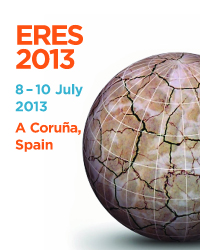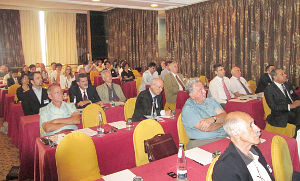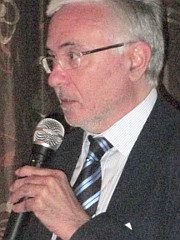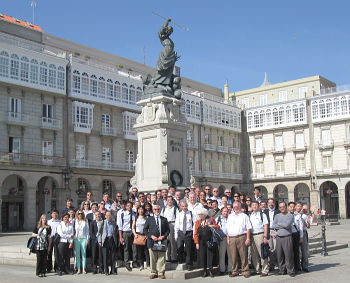9th International Conference on Earthquake Resistant Engineering Structures
A Coruña, Spain
Overview

The 9th international conference on Earthquake Resistant Engineering Structures (ERES/2013) took place n A Coruña, Spain, coorganised by the University of A Coruña represented by Prof Santiago Hernandez, and the Wessex Institute of Technology (WIT) represented by Prof Carlos A Brebbia.
The meeting started at the University of Thessaloniki in 1997 and since then it has been reconvened every two years in a series of outstanding locations and in collaboration with well-known institutions. The first conference was followed by meetings in Catania (1999); Malaga (2001); Ancona (2003), Skiathos (2005); Bologna (2007); Cyprus (2009), Tuscany (2011).
Major earthquakes and associated effects such as tsunamis stress the need to carry out more research on the topics of this conference. The problems will continue to intensify as population pressure results in building in regions of high seismic vulnerability. A better understanding of these problems is required for the safe design of earthquake resistant structures.
Papers presented at ERES conference are an invaluable record of the state of the art on that topic. They are all freely available on the website run by WIT Press (http://library.witpress.com) where they are a permanent record of the quality of the research presented at this conference series.
The conference was opened by Prof Carlos A Brebbia who commented on the different activities taking place at the Wessex Institute of Technology, in its New Forest headquarters. There WIT carries out research and training aimed to bridge the work of academic and practitioners. It also holds training courses at postgraduate and professional levels and through WIT Press its publishing arm, produces a substantial number of books other than conference proceedings as well as scientific journals. All this material is published and distributed in digital as well as hard copy format, through a distributor’s network that now covers all the world. WIT Press has grown considerably in the last few years and continues to be an important outlet for the dissemination of the latest research carried out at WIT as well as many of those associated with the Institute (see www.witpress.com).

Carlos described some case studies which illustrated research collaboration with other institutions and the use of WIT tools to solve practical engineering problems (see www.beasy.com).
Carlos ended his opening remarks by thanking the delegates for coming over to A Coruña and hoped that they will visit the Institute in the near future. He would be delighted to show them around the Campus so that they can have a better idea of the work carried out by WIT.
Prof Santiago Hernandez then proceeded to welcome the participants in the name of his University of A Coruña, explaining that technical visits to the University will take place during the meeting following the welcome address of the Mayor in the City Hall.
Conference Topics
The papers presented at the conference were grouped into the following topics:
- Seismic hazard evaluation and microzoning for structural design
- Building performance during earthquakes
- Performance based design
- Seismic hazard assessment
- Nonlinear numerical analysis
- Experimental studies
- Seismic isolation and energy dissipation
- Case studies
Special Session

‘What information is needed to design anti-seismic structures?’ (keynote address) by Paolo Clemente of ENEA Research Centre, Italy.
‘Seismic input characterization for some sites in Italy’, by Dario Rinaldis, ENEA Research Centre, Italy.
‘Earthquake recurrence and seismic hazard assessment: a comparative analysis over the Italian territory’, by Andrea Magrin, University of Trieste, Italy.
‘Studies of seismic microzonation in Latium region (Italy) by experiencing the application of official guidelines in intra-mountain plains’, by Giacomo Scarascia Mugnozza, University of Rome, La Sapienza, Italy.
‘Earthquake engineering needs and seismic hazard assessment’, by Jens-Uwe Klügel, International Seismic Safety Organisation, Switzerland.
‘3D motion capture application to seismic tests at ENEA Casaccia Research Center: 3Dvision system and disco virtual lab’ by Ivan Roselli, ENEA Research Centre, Italy.
Excursion

Carlos answered the Mayor, stressing how welcome the delegates felt in A Coruña and how positive their comments were regarding the excellent facilities and the local culture.
Prof Santiago Hernandez, member of the Board of Directors of Wessex Institute also was grateful to the City for their welcome and for the support it provides to the University.
After the visit the delegates were offered a buffet lunch at the School of Engineering of the University where afterwards Prof Santiago Hernandez gave a presentation describing the work of the School and in particular its links with WIT and the research being carried out on structural mechanics and earthquake engineering, amongst others. They have contributed also to the organisation of the tail structures in the Airbus A350 as well as the new generation of rotor engines, which aim to provide more economic aircraft.
They have designed a series of bridges as well, in collaboration with many companies in Spain, and are able to serve industry better, because of their powerful computer facilities and their up to date laboratory facilities.
Conference Dinners

The Conference dinner took place in the restaurant of the Museum of Mankind, an impressive building in granite and slate, designed by a famous architect. From the restaurant windows the whole of the Bay could be admired. The dinner consisted of a series of typical Galician dishes and wines for which the region is renowned. Carlos thanked the delegates for coming over to A Coruña and proposed a toast to international cooperation and understanding, stressing the diversity of life and culture of our planet, which was most appropriate in view of the many countries represented at the conference. At the end of the dinner a group of Galician musicians made its entrance playing the typical bagpipes, accompanied by drums. The bagpipes reveal the Celtic origins of Galicia, a city that in the ancient past had may links with the Irish and Scottish islands in general. Bagpipes are common in most local festivals and people dance to their sound, as they are more melodic than those found in Scotland for instance.
Closing of the Conference
The conference was closed by Carlos and Santiago who thanked the delegates for having come to A Coruña and hoping that they have enjoyed the opportunity of seeing a delightful part of Spain, a country renowned for its diversity and rich culture. Carlos also invited them to visit the campus of Wessex Institute in the New Forest National Park, so they can better appreciate the work carried out there.
Conference Proceedings
The proceedings of ERES 2013 - Earthquake Resistant Engineering Structures IX, 464pp (Print ISBN: 978-1-84564-736-0; eISBN: 978-1-84564-737-7) are available from WIT Press. Orders can be placed on the WIT Press web site at www.witpress.com or by email:
Papers from the conference will also be hosted online at the WIT eLibrary as Volume 132 of WIT Transactions on the Built Environment (ISSN: 1746-4498, Digital ISSN 1743-3509). For more details visit the WIT eLibrary at http://library.witpress.com


 Wessex Institute
Wessex Institute